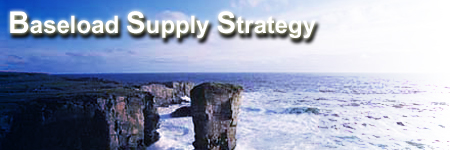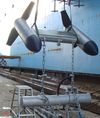


| Technology Concepts |
Differences between barrage and marine current designs
‘Tidal stream’ or ‘marine current’ energy differs from established technology of estuarine tidal barrages - e.g. the project in La Rance, France. Tidal flows are not captured using a large dam-like structure, but instead they operate in the free flow of the tides. As a result, the construction costs and ecological disruption (associated with barrages) are reduced. However, as tidal streams are a diffuse form of energy, large numbers of energy devices need to be spread over relatively large areas of seabed, for a significant amount of energy generation.
Summary of technology concepts
A number of marine current energy capture devices are in development. This section will provide an overview of a number of the main concepts:
MCT Stingray AWCG Seasnail Tidal Fence Polo Venturi Underwater kite Exim Gorlov
| Marine Current Turbines design | |
|
|
A 300 kW prototype is currently being tested off Lynmouth in Devon.
Expansion of this testing to a 2 x 500kW test-model is planned, with a target of
commercial installations by 2006. This is the most common turbine concept,
where axial flow rotors are used to drive a generator via a gearbox similar
to a hydro-electric or wind turbine. The power units of each system are mounted on
wing-like extensions either side of the tubular steel monopile, and in this design
the rotor can be raised to the surface for maintenance purposes. A similar design
by Seapower Scotland and Delta Marine is planned for implementation in the near future
to supply power to the Shetland grid. back to top |
| Stingray by Engineering Business | |
|
|
A 150kW demonstration model has been installed in the Shetlands.
The next stage is design, build and operation of a 5MW pre-commercial model after 2004.
In this design, a stack of hydroplanes have their angle relative to the water stream altered.
Lift and drag forces cause the arm to oscillate, and a hydraulic cylinder attached to the
main arm subsequently extends and retracts pumping high pressure oil to a motor /generator.
back to top |
| AWCG by Engineering Business | |
|
|
A scale model of this concept was built and tested in dry docks in 1999, but little research
has been carried out into the concept since. The Active Water Column Generator features
hydroplanes acted upon by moving water to move a part-sealed collector up and down.
As it moves, air is drawn in and expelled from top of chamber powering an air-based turbine.
back to top |
| Seasnail by Robert Gordon University and AREG | |
|
|
This research project is based more around the novel design of the turbine support frame
rather than the operation of the turbine itself. Testing of a half-size frame prototype
has taken place off Orkney, with a full size prototype, capable of generating 750 kW of
electricity planned. The 30-tonne prototype can be taken down to any depth on the sea floor
and back on command. It is expected to be useful for smaller sites and enable planning of
future developments by ease of recording site data. back to top |
| Tidal Fence by Blue Energy | |
|
|
A 100kW prototype was tested in 80s, and a 500kW pre-commercial unit near British Columbia
is currently in progress. There are plans for a full scale 50MW fence in Phillipines followed
by 2.2GW array. The basic design involves multiple 25kW vertical axis Davis Hydro turbines
installed as a tidal fence array. The Davis Hydro turbine has four fixed hydrofoil blades
connected to a rotor to drive a generator. Via hydrodynamic lift on the blades, the turbine
moves proportionately faster than speed of water. back to top |
| Polo by Edinburgh University | |
|
|
A working prototype is expected at some point in 2004. The design consists of a vertical-axis
rotor, with the generation plant at the surface in a sealed compartment at atmospheric pressure.
The rotor uses variable-pitch blades where pitch is set by control of the moment about the pitch
axis. back to top |
| Rochester / Gentec Venturi by Rvco Ltd | |
|
|
A working model (0.6m aperture system) has been tested successfully in Grimsby, and a larger
scale demonstration is expected soon, with a commercial power station to be built in Iceland
this year. The innovative concept involves a wing / funnel which is placed underwater to channel
tidal flows. As the water passes through the choke it decreases in pressure and accelerates,
sucking more water into pipes and driving an on-shore turbine to generate electricity. The
advantage of this design is that it has no moving parts under water and can generate constant power.
back to top |
| Underwater kite – Abacus Controls | |
|
|
A 40-foot wide twin-turbine is intended for deployment in the Gulf Stream off Florida. The 120kW
system also works in tidal basins and rivers. The design features a self-contained moderately buoyant
turbine-generator suspended like a kite within the tidal stream. back to top |
| Exim by Seapower, Delta, and Stromturbiner | |
|
|
A prototype turbine has been used in tests to find best site for a tidal generator to supply the
Shetland grid. Currently a final evaluation of locations with good streams is being implemented,
with the first production unit expected this year. The design features a Savonius turbine mounted
under a buoy which is anchored so that it cannot rotate with the stream. back to top |
| Gorlov Turbine by GCK Technology | |
|
|
A permanent turbine array is being installed off South Korea intended to generate 100MW. The plan
is to install 6 twin-turbines in a vertical, side-by-side arrangement. The turbine design itself
is an improvement of the Darrieus design. The blades are similar in appearance to an aeroplane
wing twisted into a helix. Water flowing into the blade causes a thrust force, and blade's
wing-shape generates lift and drag. These forces combine to rotate the turbine faster than the
water speed. back to top |
Emerging technologies
There are additional new concepts currently in development. Insufficient information was available on these concepts to allow evaluation of them for the Baseload Supply Strategy, but they are worth noting as they may emerge as strong options for future development:
- Lunar system by Lunar/Rotek
This system features a ducted turbine, fixed to the seabed via gravity foundation (therefore can be installed in deep waters without impacting shipping traffic). The blades are bi-directional rather than variable-pitch, and there is no yaw mechanism as the venturi-effect of the ducting helps to maximise the energy from the water flow, even when flow is not parallel to the turbine axis. This reduction in complexity allows for improved reliability. A 1/20th model was tested in April 2004, and a 1MW prototype is expected in 2005, with commercial launch as soon as 2006. - TidEl generator by Hydrovision
 This is a mid-depth moored concept, which can be installed in deep water, widening the potential farm area.
In no current (slack water), the turbines will float in a vertical position,
and when there is current, the turbines will naturally align themselves to the direction of the flow,
therefore no pitch or yaw mechanism is necessary. The motor is variable speed to maintain efficiency, and the fixed
pitch makes for simpler gearing.
Due to the type of installation, the concept is potentially lower impact than other concepts,
not requiring use of jack-up barges. Maintenance is not a major issue as the device cen be easily
detached from it's moorings and towed to shore for work.
Testing on a 1/10th model testing has been carried out in NaREC, Blyth.
This is a mid-depth moored concept, which can be installed in deep water, widening the potential farm area.
In no current (slack water), the turbines will float in a vertical position,
and when there is current, the turbines will naturally align themselves to the direction of the flow,
therefore no pitch or yaw mechanism is necessary. The motor is variable speed to maintain efficiency, and the fixed
pitch makes for simpler gearing.
Due to the type of installation, the concept is potentially lower impact than other concepts,
not requiring use of jack-up barges. Maintenance is not a major issue as the device cen be easily
detached from it's moorings and towed to shore for work.
Testing on a 1/10th model testing has been carried out in NaREC, Blyth.
References
- Marine Current Turbines at:
http://www.marineturbines.com - Stingray and AWCG by Engineering Business at:
http://www.engb.com/ - Seasnail by Robert Gordon University and AREG at:
http://www.rgu.ac.uk/cree/general/page.cfm?pge=10645
http://www.aberdeencity.gov.uk/.../econ_aregsub.asp
or:
Geoffrey Schoning (14 Aug 2003), Tidal Energy - A dream converted into energy, e-Newsletter from OutreachLinks
http://wire0.ises.org/wire
- Tidal Fence by Blue Energy at:
http://www.bluenergy.com - Polo by Edinburgh University at:
http://www.mech.ed.ac.uk/research/ - Rochester / Gentec Venturi by Rvco Ltd at:
http://www.rvcogen.com (website in progress) - Underwater kite by Abacus Controls at:
http://uekus.com/ - Exim by Seapower, Delta, and Stromturbiner at:
http://www.seapower.se - Gorlov Turbine by GCK Technology at:
http://www.gcktechnology.com - Lunar by Lunar Energy Ltd at:
http://www.lunarenergy.co.uk - TidEl system by Hydrovision at:
http://www.smdhydrovision.com -
Emily Rudkin, Vortec Energy Ltd (post 2001), Survey of Energy Resources - Marine Current Energy, World Energy Council at:
http://www.worldenergy.org/wec-geis/publications/reports/ser/marine/marine.asp